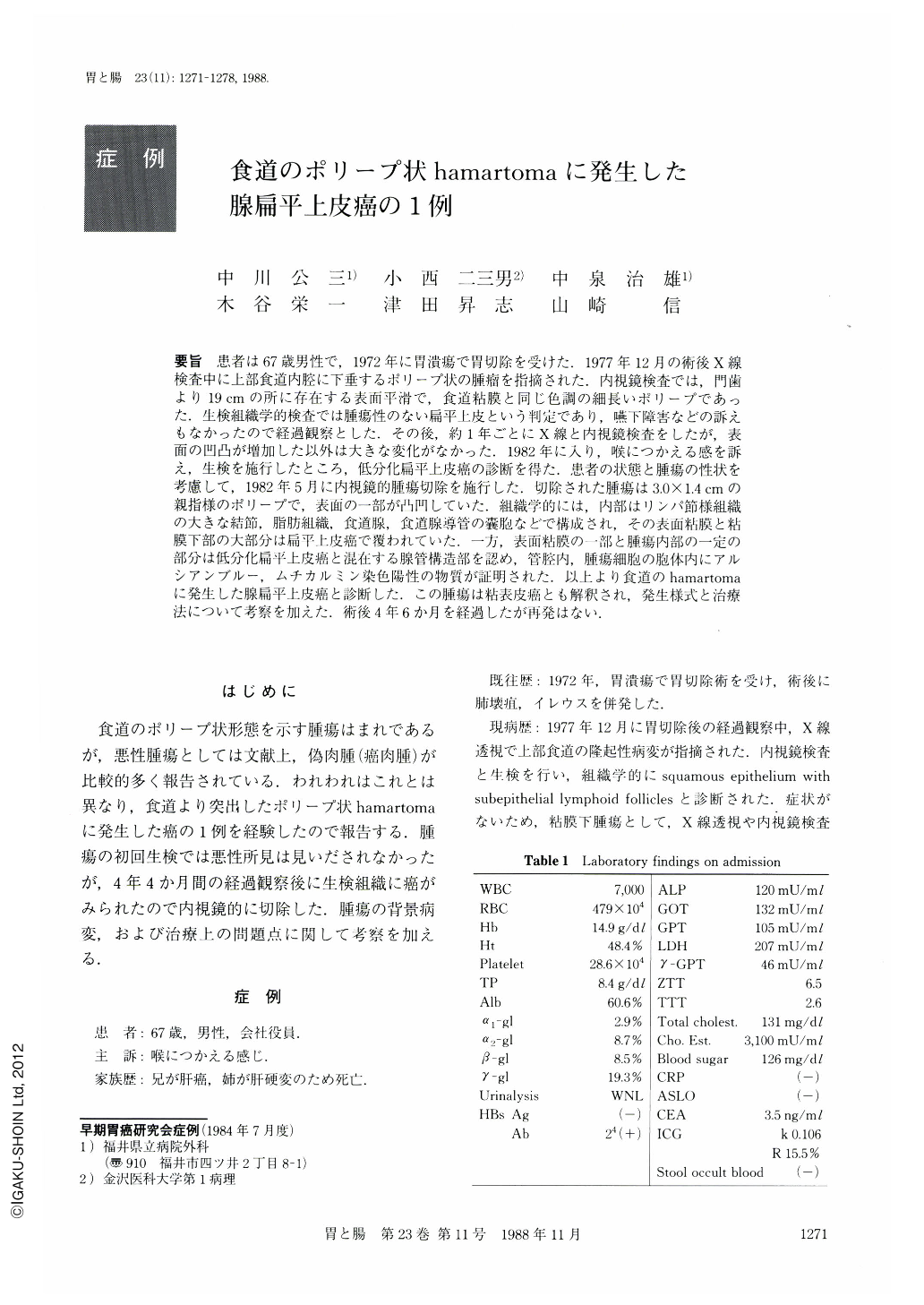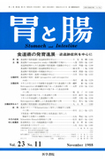Japanese
English
- 有料閲覧
- Abstract 文献概要
- 1ページ目 Look Inside
要旨 患者は67歳男性で,1972年に胃潰瘍で胃切除を受けた.1977年12月の術後X線検査中に上部食道内腔に下垂するポリープ状の腫瘤を指摘された.内視鏡検査では,門歯より19cmの所に存在する表面平滑で,食道粘膜と同じ色調の細長いポリープであった.生検組織学的検査では腫瘍性のない扁平上皮という判定であり,嚥下障害などの訴えもなかったので経過観察とした.その後,約1年ごとにX線と内視鏡検査をしたが,表面の凹凸が増加した以外は大きな変化がなかった.1982年に入り,喉につかえる感を訴え,生検を施行したところ,低分化扁平上皮癌の診断を得た.患者の状態と腫瘍の性状を考慮して,1982年5月に内視鏡的腫瘍切除を施行した.切除された腫瘍は3.0×1.4cmの親指様のポリープで,表面の一部が凸凹していた.組織学的には,内部はリンパ節様組織の大きな結節,脂肪組織,食道腺,食道腺導管の囊胞などで構成され,その表面粘膜と粘膜下部の大部分は扁平上皮癌で覆われていた.一方,表面粘膜の一部と腫瘍内部の一定の部分は低分化扁平上皮癌と混在する腺管構造部を認め,管腔内,腫瘍細胞の胞体内にアルシアンブルー,ムチカルミン染色陽性の物質が証明された.以上より食道のhamartomaに発生した腺扁平上皮癌と診断した。この腫瘍は粘表皮癌とも解釈され,発生様式と治療法について考察を加えた.術後4年6か月を経過したが再発はない.
A 67-year-old man was admitted to our hospital with a complaint of sensation of obstruction in the throat in April 1982. He had a history of gastrectomy for gastric ulcer in 1972. A pedunculated polyp of the upper esophagus was noticed at postoperative x-ray examination in December 1977 (Fig. 1).
Endoscopic examination showed an elonged, thumbshaped polypoid tumor with a smooth surface at 19 cm distant from the incisor teeth in January 1978 (Fig. 3).
Biopsy specimen taken from the tumor showed no changes except for squamous epithelium with subepithelial lymphoid follicles. He had been followed by endoscopic and fluoroscopic examination because of no complaint of swallowing disturbance at that time. The examinations from 1977 to 1982 revealed no remarkable changes in size but increasing surface irregularity (Fig. 4 a, b).
He started to complain of sensation of obstruction in the throat four years later from initial examination, so that endoscopic biopsy was done in April 1982. As the biopsy specimen showed a pooly differentiated squamous cell carcinoma, the tumor was resected endoscopically under the considerations of his general condition and past history. Resected specimen showed thumb-shaped polypoid tumor measuring 3.0×1.4 cm in size (Fig. 5).
Histologically, tumor consisted of lymphoid tissue, adipose tissue, esophageal glands, nerve, vein, hyalinized fibrous tissue and several cysts resembling esophageal ducts. The lining epithelium as well as subepithelial area was mostly occupied by squamous cell carcinoma and there are areas with features of both squamous and glandular carcinomas. Mucicarmine and alcian-blue stains demonstrated that most of the glandular structures secreted mucin substance (Figs. 6~11). Our final diagnosis was adenosquamous carcinoma (including mucoepidermoid carcinoma) arising in the pedunculated hamartoma of the esophagus. It was presumed, though not proved, that the carcinoma had its origin in the esophageal glands. The patient is well as of December 1986 with no sings suggestive of recurrence.

Copyright © 1988, Igaku-Shoin Ltd. All rights reserved.


